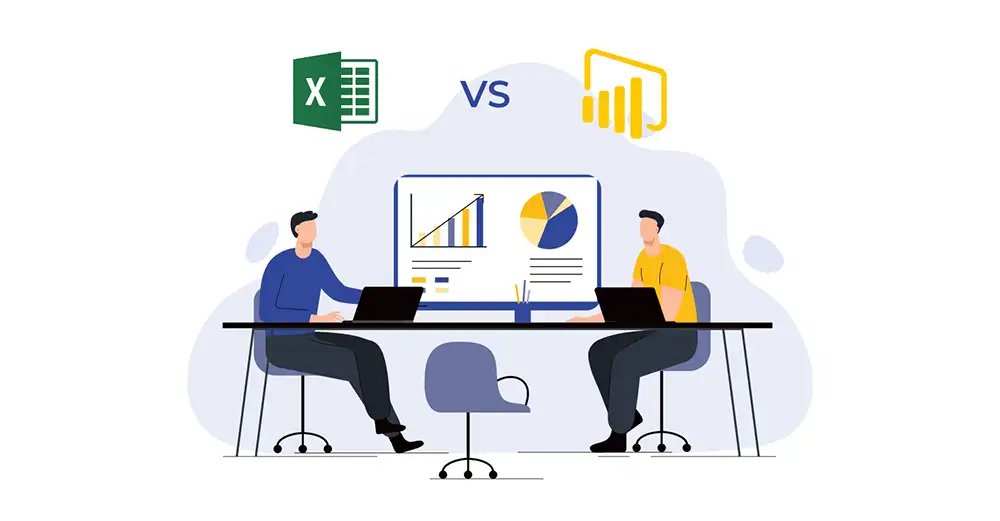 Asim Nath Dubey
Oct 07, 2025
Asim Nath Dubey
Oct 07, 2025

Power BI vs Excel: Which one to learn? The answer depends on your career goals, data analysis needs, and where you see yourself in the evolving job market. Excel remains the most widely used tool for data management, reporting, and everyday analysis. Power BI offers advanced visualisation, automation, and BI dashboards that Excel cannot match. Understanding the difference between Power BI and Excel helps you to choose the right tool for your career and data needs.
Both Excel and Power BI were developed by Microsoft, and they are widely used across industries. However, they serve different purposes, especially when it comes to business intelligence, data Analytics, reporting, and visualisation.
Not sure whether to learn Power BI or Excel? This guide explains the key differences, their features, and future scope for making the right decision.
Do you have queries such as “Is Power BI better than Excel?”, “Should I switch from Excel to Power BI?” To find the answers to all of these questions, you must first understand their differences.
Microsoft Excel is a spreadsheet application developed by Microsoft, which is a part of the Office 365 package and the Office product suite. It was first released in 1985 and has become a key software in business and research.
Excel is a key spreadsheet tool that is used to arrange and analyse data. Whether it is small or large, we can simply manage it with functions, formulas and even macros (commands that automate repetitive tasks).
MS Excel is a perfect tool for organising, analysing, and visualising large datasets. Here are some of the characteristics that make Excel an important platform for making data-driven decisions in business and finance;
Power BI is Microsoft's modern Business Intelligence (BI) tool to help you monitor Key Performance Indicators (KPIs) and extract insights from business data. This improves decision-making throughout the company. Power BI is used by developers, analysts, managers, and directors in different ways based on their roles.
There are three primary uses for Power BI:
Power BI Desktop: A free desktop program for creating and designing reports
Power BI Service: The online publishing tool for viewing and sharing dashboards and reports
Power BI mobile apps: For on-the-go dashboard and report viewing.
Read Also : How To Become A Power BI Professional
According to Gartner, Power BI is one of the top Business Intelligence (BI) tools. Power BI ranks highly because of its ease of use, strong visualisation features, AI capabilities, and real-time reporting. Here are some key features that make Power BI easy to use:
Read Also : Top Benefits of Learning Power BI for Your Career
| Features | MS Excel | MS Power BI |
| Used for | To organise, analyse, and visualise data in a spreadsheet. | For tracking KPIs and generating insights from business data. |
| Target Users | Beginners to experienced | Easy to learn for Excel users |
| Automation & Refresh | Manual updates, formulas | Scheduled refresh, real-time data |
| Flexibility | Flexible for creating customised reports and dashboards. | Less flexible than Excel, focused on automation and scalability. |
| Data Size Limit | 1,048,576 rows and 16,384 columns | Dataset limit of 1 GB (higher with Premium capacity - 100 GB - 400 GB) |
| Cloud-Based Features | There is no direct cloud-based publishing service; sharing is done manually (via file). | With a PRO license, Power BI Service provides for easy sharing. |
| Data Visualization | Excel offers:
|
Power BI offers:
|
| Business Intelligence (BI) | Excel is ideal for:
|
Power BI is ideal for:
|
| Cost | Excel costs $159.99 (Microsoft Word, PowerPoint, and Teams). | Power BI costs $14–$24/user/month (Free & Enterprise plans available). |
| Data Security | Limited data security features, Password protection for workbooks | Access controls and role-based permissions, like secure sharing. |
| AI Features | Limited AI Features | AI features like clustering, time-series analysis, and NLP (Q&A feature). |
| Data Sources | Local files, CSV, manual input | Databases, APIs, Excel, Cloud |
| Reporting & Automation | Excel provides:
|
Power BI provides:
|
Excel and Power BI also have important similarities in functionality and design.
To choose the right software, first understand what each one brings to the table. Excel is great for quick and personal data work, like calculations and simple charts. Power BI is better for bigger projects that need teamwork, interactive dashboards, and detailed reports. Let’s look at both MS software more closely to see which one suits your needs best.
Microsoft Excel is the most popular tool for organising data, conducting analysis, and boosting productivity across industries. It is best suited for:
Microsoft Power BI is a unified platform for self-service and business intelligence. It is primarily used by:
Power BI and Excel offer excellent career opportunities, but Power BI's demand is rising faster due to increased adoption across industries like technology, healthcare, and e-commerce.
Today, top organisations like WALMART, ABB, Saudi Aramco, AMD, Coca-Cola, and even SpaceX rely on Microsoft Power BI to power their business intelligence and data analytics. According to Microsoft, over 95% of Fortune 500 companies reportedly use Power BI as part of their data strategy.
Meanwhile, Microsoft Excel, another powerhouse from Microsoft, continues to dominate among micro, small, and medium-sized businesses. Its versatility, familiarity, and powerful data features make it the go-to tool for everyday reporting, analysis, and quick insights.
Clearly, both Excel and Power BI skills are extremely valuable for jobs and career growth across industries in 2026, making professionals with these abilities highly sought after by employers.
|
Keep in Mind:
|
Choosing from Power BI/MS Excel is not about replacing one with the other; it’s about choosing the right tool for your career goals. Excel builds your foundation, while Power BI helps you scale into advanced analytics.
The need for qualified analysts is still increasing. So, gaining proficiency in Excel, Power BI, or both can lead to improved job roles, increased pay, and career advancement. Your goals will ultimately determine which option is best for you, but mastering both will prepare your career for the future.
1. Is Power BI harder to learn than Excel?
Power BI is not easy to learn for a beginner, but if you already know Excel, you’ll find many concepts familiar.
2. Can Power BI completely replace Excel?
No. Excel is still essential for detailed calculations, modelling, and ad hoc analysis, while Power BI excels at dashboards and automation.
3. Which has better career opportunities in 2026: Excel or Power BI?
Power BI is more in demand for analytics and BI roles, but Excel remains indispensable in finance, HR, and administration.
4. Do I need to know Excel before learning Power BI?
It’s not mandatory, but having a solid grasp of Excel makes transitioning to Power BI much easier.
5. What are the reasons why you should do data analytics with a Power BI?
Power BI automates data refresh, integrates with cloud platforms, and provides real-time dashboards, making it ideal for modern analytics needs.

Asim Nath is an Accounting and Microsoft Office trainer at Edoxi Training Institute. He has over 13 years of training experience and has successfully trained more than 3000 professionals in Accounting and Microsoft Office applications. Asim’s specialisations include Financial Accounting, Tally, Zoho and Quickbooks. His background in financial accounting adds valuable insights to business presentation training.
Asim is an expert in MS Office, including PowerPoint, Excel, and Power BI, positioning him as a well-rounded specialist in the Microsoft Suite. Asim employs a practical, business-focused teaching methodology. His one-to-one training approach ensures each student receives personalized attention. He emphasizes real-world applications, helping professionals create impactful business presentations.